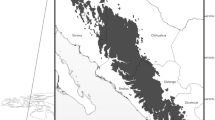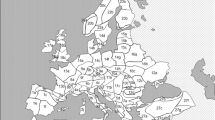Abstract
Many hypotheses have been proposed to explain the origin and maintenance of the Amazonian diversity with special place for the theory of isolation by rivers and a set of hypothesis related to contemporary environmental dissimilarity. We explore those hypotheses here using the biogeographic distributional patterns of dragonflies in interfluve areas of the Amazonian biome and also evaluate how differences among in dispersal capabilities between the Anisoptera and Zygoptera suborders may contribute to those patterns. We used distributional information of 392 odonate species in the Amazonian forest in a cladistic analysis of distributions and endemism and the estimated faunistic similarity among interfluves with the Sorensen index. The environmental similarity among interfluves was analysed by discriminant analysis based on eight environmental metrics. Different metrics for geographic distance (connectivity) among interfluves were evaluated and their relation to the other variables tested by the Mantel test. The number of endemic species was linearly correlated to the area of the interfluves. General endemism patterns showed consistent resemblance to those reported for vertebrates, especially the similarity among the Rondônia and Inambari interfluves. Geographical distance has no predictive value for dragonflies distribution, but the environmental similarity is a good predictor of proportion of shared species. The low dispersal group (Zygoptera) presented more clear patterns of distribution and a lower proportion of shared species among different interfluves. The environmental similarity can be considered the determinant factor of the distribution of dragonflies, possibly due to environmental specificity evolved during a long history of some clades in this system. The low dispersal group (Zygoptera) retained more biogeographical information about possible historical factors that determine current distribution. Also, the transport of larvae by macrophyte banks, the lateral change of river courses, the reversal of the drainage basin, together with the capacity to disperse across rivers for some species may be explanations for the lack of effect of isolation by rivers, especially for Anisoptera.




Similar content being viewed by others
References
Albrecht GH (1980) Multivariate analysis and the study of form, with special reference to canonical variate analysis. Am Zool 20:679–693
Aleixo A (2004) Historical diversification of a terra-firme forest bird superspecies: a phylogeographic perspective on the role of different hypotheses of Amazonian diversification. Evolution 58:1303–1317
Bates JM, Hackett SJ, Cracraft J (1998) Area-relationships in the neotropical lowlands: an hypothesis based on raw distributions of passerine birds. J Biogeogr 25:783–793
Bates JM, Haffer J, Grismer E (2004) Avian mitochontrial DNA sequence divergence across a headwater stream of the Rio Tapajós a major amazonian river. J Ornithol 145:199–205
Brooks DR, van Veller MGP (2003) Critique of parsimony analysis of endemicity as a method of historical biogeography. J Biogeogr 30:819–825
Corbet PS (1999) Dragonflies: behavior and ecology of Odonata. Comstock Publishing Associates, Ithaca
Cracraft J (1991) Patterns of diversification within continental biotas: hierarchical congruence among the areas of endemism of Australian vertebrates. Aust Syst Bot 4:211–227
Cracraft J, Prum RO (1988) Patterns and processes of diversification: speciation and historical congruence in some neotropical birds. Evolution 42:603–620
De Marco P Jr, Vianna DM (2005) Distribuição do esforço de coleta de Odonata no Brasil: subsídios para escolha de áreas prioritárias para levantamentos faunísticos. Lundiana 6:13–26
Diniz-Filho JAF, Bini LM, Pinto MP et al (2007) Conservation biogeography of anurans in Brazilian Cerrado. Biodivers Conserv 16:997–1008
Diniz-Filho JAF, De Marco P, Hawkins BA Jr (2010) Defying the curse of ignorance: perspectives in insect macroecology and conservation biogeography. Insect Conserv Divers 3:172–179
Duque A, Sánches C, Cavelier J, Duivenvoorden JF (2002) Different floristic patterns of woody understorey and canopy plants in Colombian Amazonia. J Trop Ecol 18:499–525
Fattorini S (2007) Levels of endemism are not necessarily biased by the co-presence of species with different range sizes: a case study of Vilenkin and Chikatunov’s models. J Biogeogr 34(6):994–1007
Felsenstein J (1985) Confidence limites on phylogenies: an approach using the bootstrap. Evol Anthropol 39:783–791
Gascon C, Malcolm JR, Patton JL et al (2000) Riverine barriers and the geographic distribution of Amazonian species. Proc Natl Acad Sci USA 97:13672–113677
Haffer J (2001) Hypotheses to explain the origin of species in Amazonia. In: Vieira ICG, Silva JMC, Oren DC, D’Incao MA (eds) Diversidade biológica e cultural da Amazônia, Belém , pp 45–118
Hayes FE, Sewlal JN (2004) The Amazon River as a dispersal barrier to passerine birds: effects of river width, habitat and taxonomy. J Biogeogr 31:1809–1818
Hoorn C, Vohof H (2006) Neogene Amazonia: introduction to the special issue. J South Am Earth Sci 2:1–4
Jones MM, Tuomisto H, Clark DA, Olivas P (2006) Effects of mesoscale environmental heterogeneity and dispersal limitation on floristic variation in rain forest ferns. J Ecol 94:181–195
Juen L, De Marco P Jr (2011) Odonate biodiversity in terra-firme forest streamlets in Central Amazonia: on the relative effects of neutral and niche drivers at small geographical extents. Insect Conserv Diver 4:1–10
Junk WJ (1973) Investigations on the ecology and production-biology of the “floating meadows” (Paspalo-Echinochloetum) on the middle Amazon. II. The aquatic fauna in the root-zone of floating vegetation. Amazoniana 4:9–102
Lobo JM, Verdú JR, Numa C (2006) Environmental and geographical factors affecting the Iberian distribution of flightless Jekelius species (Coleoptera: geotrupidae). Divers Distrib 12:179–188
Lougheed LW, Breault A, Lank DB (1999) Estimating statistical power to evaluate ongoing waterfowl population monitoring. J Wildl Manag 63:1359–1369
Manly BFJ (2004) Multivariate statistical methods: a primer. Chapman and Hall, London
Marroig G, Cerqueira R (1997) Plio-pleistocene South American history and the Amazon Lagoon hypothesis: a piece in the puzzle of Amazonian diversification. J Comp Biol 2:103–119
May ML (1981) Allometric analysis of body and wing dimensions of male anisoptera. Odonatologica 10:279–291
Oksanen J, Blanchet FG, Kindt R, Legendre P, Minchin PR, O’Hara RB et al. (2011) Vegan: Community Ecology Package. R package version 2.0-2
Patton JL, Silva MNF, Malcon JR (2000) Mammals of the Rio Juruá and the evolutionary and ecological diversification of Amazônia. Bull Am Mus Nat Hist 244:1–305
Peres CA, Patton JL, Dasilva MNF (1996) Riverine barriers and gene flow in Amazonian saddle-back tamarins. Folia Primatol 67:113–124
Porzecanski AL, Cracraft J (2005) Cladistic analysis of distributions and endemism (CADE): using raw distributions of birds to unravel the biogeography of the South American aridlands. J Biogeogr 32:261–275
R Development Core Team (2011) R: A language and environment for statistical computing. R Foundation for Statistical Computing, Vienna
Resende DC, De Marco P Jr (2010) First description of reproductive behavior of the Amazonian damselfy Chalcopteryx rutilans (Rambur) (Odonata, Polythoridae). Rev Bras Entomol 54:436–440
Roddaz M, Baby P, Brusset S, Hermoza W, Darrozes JM (2005) Forebulge dynamics and environmental control in Western Amazonia: the case study of the Arch of Iquitos (Peru). Tectonophysics 399:87–108
Ron SR (2000) Biogeographic area relationships of lowland Neotropical rainforest based on raw distributions of vertebrate groups. Biol J Linn Soc 71:379–402
Salo J, Kalliola R, Hakkinen I et al (1986) River dynamics and the diversity of Amazon lowland forest. Nature 322:254–258
Silsby J (2001) Dragonflies of the world. Smithsonian Institution Press, Washington
Silva JMC (1996) Application of parsimony analysis of endemicity in Amazonian biogeography: an example with primates. Biol J Linn Soc 59:427–437
Silva MNF, Patton JL (1998) Molecular phylogeography and the evolution and conservation of Amazonian mammals. Mol Ecol 7:486
Silva JMC, Rylands AB, Fonseca GAB (2005) The fate of the Amazonian areas of endemism. Conserv Biol 19:689–694
Steinitz O, Heller J, Tsoar A, Rotem D, Kadmon R (2006) Environment, dispersal and patterns of species similarity. J Biogeogr 33:1044–1054
Swofford DL (1998) PAUP*. Phylogenetic analysis using parsimony (*and other methods). Version 4, Sinauer Associates, Sunderland
Wesselingh FP, Salo JA (2006) A Miocene perspective on the evolution of the Amazonian biota. Scripta Geol 133:439–458
Wesselingh FP, Räsänen ME, Vonhof HB et al (2001) Lake Pebas: a palaeoecological reconstruction of a Miocene, long-lived lake complex in western Amazonia. Cainozoic Res 1:35–81
Willis JC (1922) Age and area. a study in geographical distribution and origin of species. Cambridge University Press, London
Acknowledgments
We thank J. A. Diniz-Filho, J. M. Lobo and A. S. Melo for reviewing an early draft of this manuscript. We are grateful for the support provided by the students and researchers of the Laboratório de Ecologia Teórica e Síntese (UFG). L. Juen had CAPES by the scholarship and P. De Marco by a series of CNPq productivity fellowship.
Author information
Authors and Affiliations
Corresponding author
Electronic supplementary material
Below is the link to the electronic supplementary material.
Rights and permissions
About this article
Cite this article
Juen, L., De Marco, P. Dragonfly endemism in the Brazilian Amazon: competing hypotheses for biogeographical patterns. Biodivers Conserv 21, 3507–3521 (2012). https://doi.org/10.1007/s10531-012-0377-0
Received:
Accepted:
Published:
Issue Date:
DOI: https://doi.org/10.1007/s10531-012-0377-0




